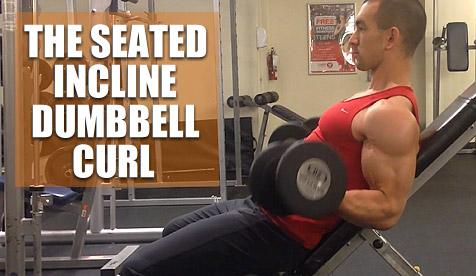THE SEATED INCLINE DUMBBELL CURL (TOP BICEP CURL VARIATION)

While it is true that a good portion of your bicep growth will simply come as an automatic result of compound back training, combining the proper curling variations with the correct form is still an important means of optimizing your upper arm gains.
The seated incline dumbbell curl is a great choice when it comes to direct bicep training, as the position of the movement allows for a full stretch on the biceps in the bottom position and a very strong contraction at the top.
In addition, the use of dumbbells allows each arm to move independently, preventing size and strength imbalances and ensuring equal development of both sides.
Here’s how to perform this exercise properly for the very best bicep building results…
Proper Seated Incline Dumbbell Curl Form
The basic form for the seated incline dumbbell curl is pretty straightforward…
1) Adjust an incline bench at roughly a 45 degree angle and hold a pair of dumbbells at your sides with your palms facing up.
2) Curl the dumbbells up until you feel a full contraction in your biceps, pause briefly at the top, and then lower them back down to the starting position.
Simple enough, right?
It is, but there are several other small form cues you’ll want to pay attention to if you really want to maximize the effectiveness of the exercise and place as much tension on your biceps as possible.
It will take a bit of practice to get all of these down, but here are some highly effective tips for performing your seated incline dumbbell curls in the optimal fashion…
Additional Form Tips
* Do not allow your elbows to excessively drift forward as you curl the weight up, as this directs the tension off of the biceps and onto the front delts instead. A bit of movement is fine, but try to keep your elbows relatively stationary.
* Do not curl the weight so high up that the tension leaves the biceps. Simply curl the dumbbells to the point where you feel a full contraction in your biceps and then stop there and let the weight back down. Your goal should be to keep your biceps under continual stress at every point in the exercise.
* Keep your elbows pinned at your sides throughout the entire movement and do not allow them to flare outward.
* Keep your wrists aligned in a neutral or slightly extended position. If you flex your wrists as you curl the weight up, all you’re doing is directing more tension onto your forearm muscles and increasing the stress on your wrist joints.
* In order to get a full stretch in the biceps and utilize the largest range of motion possible, flex your triceps at the bottom of each rep.
Give the seated incline dumbbell curl a try during your next bicep workout, practice the form tips I’ve outlined above, and I think you’ll be very pleased with the results.
Proper bicep training is far from rocket science, but combining the unique angle of this exercise along with these various form tips is a great way to ensure that you get the very most out of your direct arm workouts.
If you found this article helpful, make sure to sign up for your FREE custom fitness plan below...




